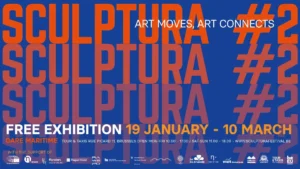At the invitation of White Carrara 2023, Italian artist Mattia Bosco will have a monumental installation on display in the historic city center of the world marble capital through October 1. Entitled “Sezione Aurea” (Golden Cross-Sections), this installation speaks to the artist’s unique relationship with his preferred medium and with his practice as a sculptor, which he defines as a “meeting between two pieces of the world that are collaborating in an interplay of forces”.

This is where Michelangelo sourced the stone for his sculptures; the city of Carrara has long been associated with processing marble from the neighboring Apuan Alps. For more than three months (June 17 to October 1), the White Carrara festival celebrates this legacy while highlighting the city’s contemporary role as a hotbed of creative evolution.
The 2023 edition, whose theme is “STILL LIV(F)E – The Forms of Sculpture”, stages a dialogue between the work of sculptors, whose monumental creations populate the historic heart of this Tuscan town, and the perspectives of photographers (“Visioni Plastiche” exhibition at the former San Giacomo hospital) and documentarians.
The eight artists selected by Claudio Composti, the event’s artistic director, express in their works the polymorphic nature of the language of sculpture. One of these artists is Mattia Bosco, who is represented by Artistics. His installation, “Sezione Aurea” (Golden Cross-Sections), can be found at the Piazza del Duomo. Produced specifically for the festival, it comprises three monumental sculptures in Carrara marble, the sculpted parts of which are covered in 23.8-carat gold leaf.
“It was important to me to choose a place where the sculptures I imagined in my head would find the best conditions to come to life. I recalled the Carrara cathedral, with its unusual placement, set back with a facade that is almost hidden by houses. Its long, marble flank with no windows – save for a small side door – was the perfect backdrop for unobstructed views of the sculptures. The triangular shape of this piazza, which is not really a piazza, gave me the idea to carve out an additional space defined by three sculptures that would be in conversation with one another and resonate with the shape of their display area. These three sculptures were born together; I sculpted them by positioning them in relation to one another in the studio at Barattini’s, who gave me his wonderful marble from the Michelangelo quarries. I approached the sculptures almost simultaneously, so that they are really responding to one another, like a dialogue in which a question asked by one participant is answered by the other two. They were born to complement one another in their very differences, and their individuality is the result of this simultaneous birth, even if they may take different paths in the future, like brothers or sisters.”
Indeed, Mattia Bosco‘s installation occupies the space as if it had always been there. One might even note with amusement that there seems to be resonance between the shapes of the sculptures and their architectural setting, although this does not reflect an intentional choice by the artist:
“I think the resonance is more spiritual than symbolic. My sculptures represent nothing more than themselves; they are not a half that alludes to a whole, like a symbol. I believe that the resonance lies in the spirituality of the material, which is found in both the cathedral and my sculptures.”
“Sezione Aurea” is consistent with the artist’s approach as he seeks to create a dialogue with the material, through which sculpture becomes an act of collaboration in which the material reveals itself. The sculptor’s involvement is not to invent a shape, but rather to free the form that already inhabits the material, where the formal process is already under way.
“In my view, marble is not a material substrate devoid of form, but rather something that always presents itself immediately with its individuality. I never encounter ‘marble’ as such: I see a specific piece of marble, this one and not that one. That is why I may choose one piece and reject others. (…) An idea that you can insert into any piece of marble is an idea that does not interact with the material, that cannot really come to be. A sculpture that emphasizes the idea to the detriment of the material – what kind of sculpture is that? What connection does it have with its other essential component, the medium, if not a utilitarian, functional relationship? A sculpture made that way could be produced by an experienced craftsman or a robot, because the idea, or the plan, only needs to be executed and does not seek to learn from the material or process of coming into being. It only dictates. When seen this way, the material becomes a whole emptied of any qualities. At the same time, the shape idea is stripped of any tension and any risk of not successfully imposing itself on the medium. Stripping away the possibility of failure also strips away the possibility of success; it comes down to purely mechanical execution. For me, sculpture is a meeting between two pieces of the world that are collaborating in an interplay of forces. And a successful sculpture is the place where these tensions, this desire and this journey of medium to form come together”.
WHITE CARRARA 023
Still Liv(f)e
whitecarrara.it












